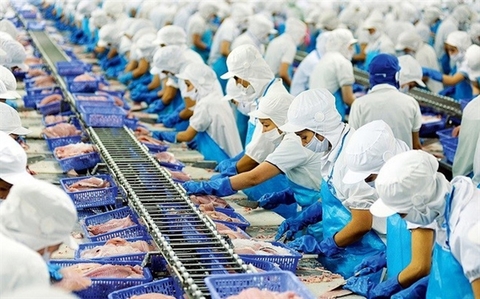
Workers on a canned food production line of Royal Foods Nghe An Factory in Nam Cam Industrial Park (Southeast Economic Zone). — Photo baonghean.vn
Foreign direct investment (FDI) has contributed significantly to the economic development of Nghe An Province but more actions are needed to improve its efficiency and increase FDI enterprises' contribution to the State budget.
Located in the heart of the North Central Region, the province has attracted 249 projects with a total registered capital of almost VND62 trillion (US$2.7 billion), 48 of which are FDI projects with total investment of $825.3 million.
Some large-scale FDI projects in the Southeast Nghe An economic zone include $140 million Luxshare-ICT project invested by Hong Kong-based Luxshare ICT (Nghe An) Co Ltd; Viet Nam-Singapore Industrial Park (VSIP) invested by Singapore’s VSIP Nghe An Co Ltd with a total investment of $76.4 million; and Thai WHA Group’s WHA Nghe An Industrial Zone – the first phase worth $92.2 million.
FDI projects in the province focus on labour-intensive sectors such as garment and textile, electronic components manufacturing, agricultural and forestry products processing and consumer goods production. These projects employ a large amount of labour, especially unskilled workers in the province, while at the same time developing services attached to operations of industrial parks such as accommodation, catering and trades.
According to the Southeast Economic Zone Management Board, FDI projects have contributed to improving the investment environment in the locality, helping train local workers and strengthen governance skills of managers. Many foreign-invested enterprises have also paid attention to giving back to the community through social responsibility activities.
However, FDI projects invested in the province are mostly small-scale and their contribution to the State budget is insignificant and much lower compared to the domestic enterprises.
In 2019, payment to the State budget of FDI enterprises accounted for less than 12 per cent of total contribution of all enterprises in the Southeast Economic Zone.
The board highlighted more measures are needed to put into place to improve the FDI efficiency and quality of operations of FDI enterprises in the province.
The first and most important thing is to enhance mechanisms and support policies to attract FDI, including more incentives, administrative reform and improvement of the business and investment environment of the province.
The province needs to review and adjust the master plan on construction of the Southeast Economic Zone, reshaping functional zones and industrial parks to meet the requirements of high-quality FDI in the next five-year period.
Infrastructure is a key issue that needs the highest priority. The province needs to build a comprehensive system of infrastructure, transportation, seaports, urban areas and hospitality services to facilitate operation of FDI investors.
The FDI attraction approach should also be changed to be proactive when seeking investment with priority given to big and multinational corporations with advanced technology, technology transfer commitment and environmentally friendly projects.
In the long term, the province needs to attract projects with high value-added chains such as automobile and motorcycle manufacture and assembly; manufacturing and assembling electronic components, computers; key mechanical industries and high-tech processing and manufacturing.
To attract high-quality FDI, the tasks of training and developing local human resources and improving qualification of government officials also need more attention.
Currently, the Southeastern Economic Zone Management Board is supporting investment procedures for a number of large-scale projects such as Juteng Group's $200 million computer manufacturing and assembly project, USA Everwin Group's $200 million electronic equipment and component manufacturing project and Foxconn’s $300 million electronic component manufacturing project. — VNS